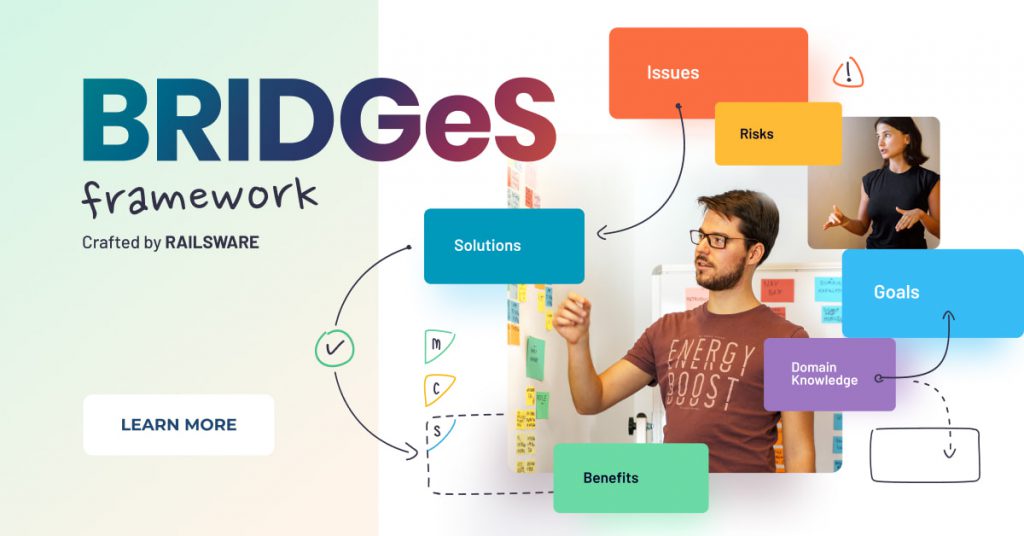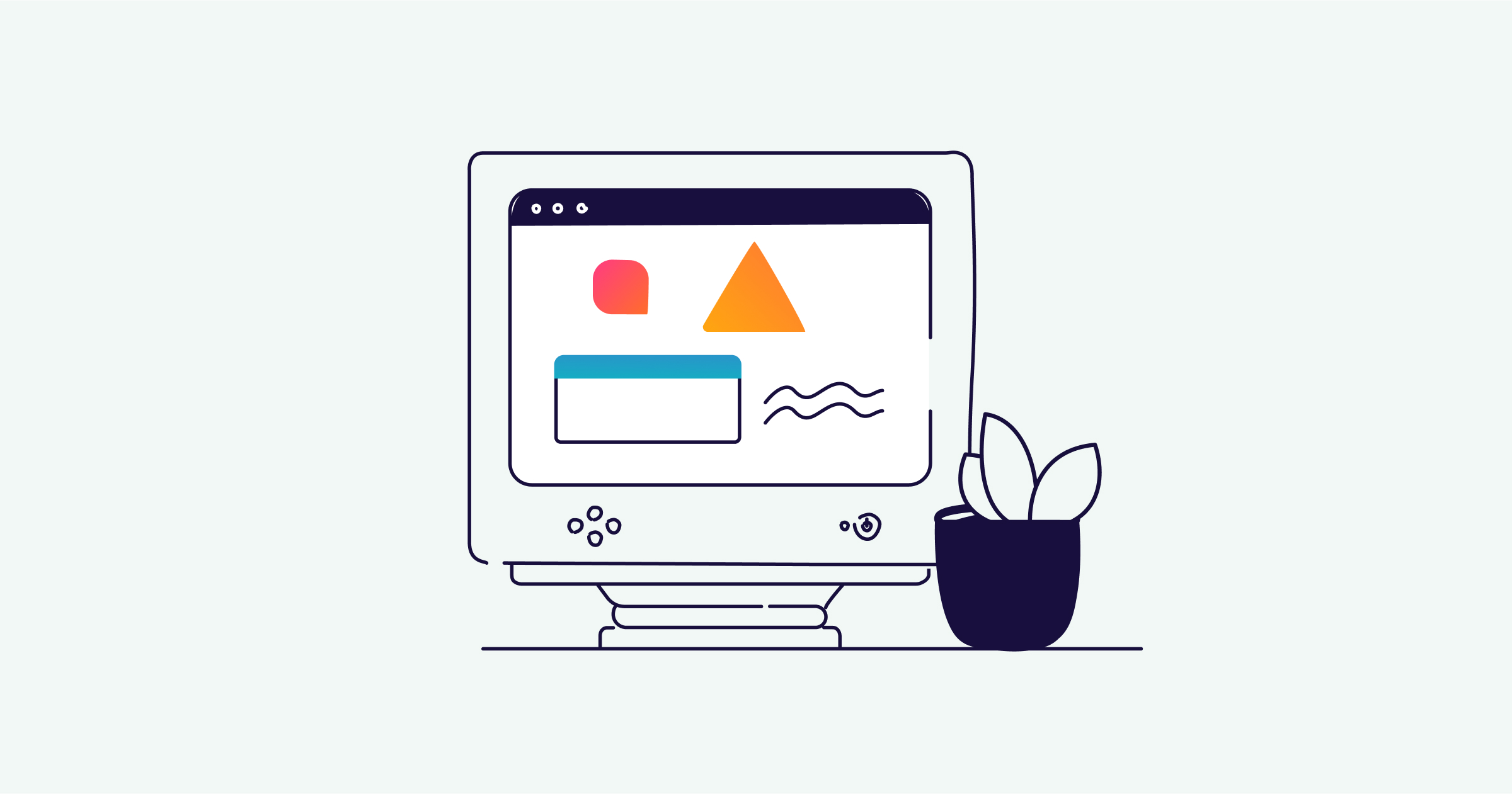
We’ll get to that, but for now, let’s offer some insight into the current market. Here are a few key stats:
- The SaaS market is on track to be worth $195 billion in 2023, up from $167bn in 2022.
- End-user spending has increased 500% over the past 8 years.
- Enterprise (B2B) software accounts for 70% of the global SaaS market.
- The average business used about 130 SaaS apps in 2022, up 18% from the previous year.
- B2B dominated the top 5 best-selling SaaS categories in 2022: CRM, Cybersecurity, APM, Project Management, and Business Intelligence platforms.
- According to Crunchbase, 280 SaaS companies were founded in the last 12 months.
This graph shows how much the interest in B2B SaaS has surged since 2018:
What is B2B SaaS?
Even in the face of a funding winter and global economic uncertainty, the SaaS industry booms. End-user spending is still on the rise. But what’s all the fuss about? To answer that question, we first need to explore the background and history behind this type of software.
B2B SaaS stands for Business-to-Business Software-as-a-Service. It refers to software that is:
- Specifically designed for use by businesses (e.g. project management software)
- Cloud-hosted and sold as a service over the internet
- Available to businesses who pay a monthly/annual subscription
Organizations leverage B2B SaaS products to improve team productivity, streamline operations, and manage various business functions. As such, B2B SaaS spans everything from project management hubs (solutions like Asana, Jira), graphic/product design platforms (Adobe, Bubble) and website design solutions to fintech (Stripe, Carta) and human resource management tools (Lattice, Personio).
The roots of B2B SaaS
Let’s go back to the early 90s. The internet hasn’t come into its own yet and, for most people, ‘cloud’ still has nothing to do with computers. Meanwhile, on-premise enterprise software is alive and well. It comes in the form of floppy disks or CD-ROMs and requires manual installation. Many businesses rely on software experts to interpret how to operate and customize it. Or they build their own cumbersome, expensive-to-maintain in-house solutions. None of this is ideal. But for now, it’s the only option.
Shift to cloud computing
Fast forward to the early noughties. Cloud-hosting is gaining traction. More businesses have access to a stable internet connection and it’s easier to transact over the web.
Salesforce has launched its CRM platform. It’s one of the first companies to offer this type of service over the internet via a subscription model. Businesses can now ‘rent’ complex software monthly/annually instead of paying a huge fee upfront – a real game-changer. And they can say goodbye to on-site servers, which frequently break down and eat into their operational budgets.
Snowball effect
It’s not long before hundreds of other software companies (both new and old) start adopting the SaaS model: WebEx, Workday, Zendesk. Demand for B2B SaaS solutions grows as more and more startups join the scene. It happens like this: project management SaaS companies start buying subscriptions for other B2B SaaS products – digital marketing tools, payroll software, HR management platforms, etc. – and this fuels the establishment of even more startups.
Over time, the design, functionality, and stability of web applications improve. The industry experiences rapid growth from the 2010s onwards. And that brings us all the way here, to 2023 – a time that’s just as good as any to break into the B2B SaaS market.
Why is SaaS model so popular?
We’ve explained how and why B2B SaaS came to be. So let’s expand a bit on why so many businesses and startuppers are keen to use and create these types of products.
Why SaaS appeals to businesses
Affordability. SaaS products are simply cheaper than the old alternatives. The costs of lifetime licenses, yearly upgrades, and the hardware (on-site servers) needed to host the software used to take a toll on company budgets. Now, businesses can comfortably ‘rent’ complex solutions, instead of having to pay an enormous fee upfront.
For example, if you bought a license for Adobe Creative Suite in 2010, it would set you back about $2K for the year – not including any updates that come after that date. But if you were to purchase a license for their Creative Cloud in 2023, you’d only pay about $1K total annually.
Flexibility. SaaS products are scaleable and much easier to customize than on-premise software. Businesses have more control over costs, as well as who has access to the software, and how their team interacts with it. Products like Figma and Slack allow you to adapt your subscription to reflect the size and changing needs of your organization. Not to mention, you can unsubscribe at any time, and not have to worry about the sunk cost.
Regular, free updates. Pre-B2B SaaS, free software updates weren’t really a thing. Businesses had to buy new, updated versions every year e.g. QuickBooks Pro 2010, QuickBooks Pro 2011, and so on. Bugs weren’t fixed on the fly; businesses had to wait at least 12 months for new features. Nowadays, bugs are usually fixed pretty quickly, and new features are added at no extra cost to the user.
Why the SaaS model appeals to startuppers
Predictability. The SaaS model makes it easier for companies to predict future revenue. You can bet that as long as your solution provides enough value, customers will keep paying month after month. There are no guarantees, but teams can make solid calculations about finances, hiring, and resource allocation by tracking subscription data and other product metrics. On the other hand, one-time sales are much less reliable – what’s to say customers will buy the next version of your product? Ultimately, SaaS companies earn more long-term, since they come with built-in sustainability.
Potential to secure investment. And as the stats show, the recent economic climate hasn’t restricted access to venture capital – if your idea is solid, it’s still possible to get pre-seed investment. This long list of companies that got funded in 2022/23 proves that. Investors simply appreciate the increased transparency that SaaS models offer. They can look at sign-ups, MRR, and active users and grasp whether or not the product has been, or can be, successful.
Low barrier to entry. It’s not hard to get a B2B SaaS product off the ground, even when you’re not super technical or can’t afford a software development team. In fact, you can build a no-code MVP in a matter of hours. There are a growing number of solopreneurs, and a 2023 study shows that only 10% of them come from tech-related backgrounds. On top of that, niche SaaS markets like real estate, construction, healthcare, and education offer tons of potential. There’s less competition in these areas, and huge audiences to cater to.
Easy to turn a profit. You don’t need a giant user base to create a profitable B2B SaaS company. This type of model benefits from a higher customer lifetime value – once a business chooses your solution, they won’t switch to a competitor unless they feel compelled to (budget constraints, poor experience). It’s simply too complicated and expensive to ‘move out’. Not to mention, businesses have deeper pockets than B2C users. So really, you can be profitable with even just 1K loyal customers.
Low overheads. Unlike hardware and on-premise software companies, B2B SaaS startups don’t have to invest in things like manufacturing, distribution, or on-site server maintenance. And many companies can operate remotely, which further reduces operational costs. Ultimately, that leaves you with more cash to spare.
B2B vs B2C SaaS
There are two business models for SaaS applications: B2B and B2C. What sets them apart? Here are the 3 key differences:
1. Product purpose
Yes, both B2B and B2C SaaS products are packaged and sold in the same way: web/mobile applications, cloud-hosted, and provided as a service over the internet. But a B2B SaaS app that allows nursing homes to keep track of patient health records won’t get engagement from the general public. It sticks to solving a specific business problem for a specific audience. Meanwhile, B2C SaaS apps have a broader focus and a wider audience. Products revolve around personal productivity, well-being, fitness, edutainment, gaming, or recreation.
It’s worth mentioning that many SaaS companies aren’t exclusively B2B or B2C, but they do lean more one way than the other. For example, the productivity and notetaking app Notion is primarily a B2B. But it’s also popular with individuals who want to organize tasks in their personal lives (e.g side projects, job hunting, wedding planning).
That said, it’s important to know who your ideal customer is from the very beginning. CEO & Co-founder of Ling App, Simon Bacher, warns: “Not being clear from the get-go whether you’re a B2B or B2C company will cause hiccups and industry confusion. Ling is experiencing this at the moment. Initially, we took the B2C route and are now pivoting to B2B, but our intended audience is finding our offering confusing, as it doesn’t strictly serve businesses. So if you’re going to go the B2B SaaS route, do it from the get-go. Don’t change your path.”
2. Design and feature set
B2B SaaS applications typically have way more functionality, complexity, and specialized features than their B2C counterparts. B2C SaaS generally has a more laid-back, user-friendly, playful design. Features are geared towards individual users who may not have the same level of technical expertise or specific business requirements as B2B customers.
The difference is stark if we compare a product like NetSuite (business management software) with Netflix. Oracle’s NetSuite is vast, cluttered, and tricky to navigate if you don’t know what you’re doing. It covers everything from business analytics and sales to payroll and HR functions. Meanwhile, Netflix is built to entertain. It has an unfussy, colorful UI with simple navigation and very few complex features.
3. Target customer
B2B SaaS companies target other businesses (and their various decision-makers) as customers, while in the case of B2C, customers are individuals (the average joe).
B2B – Slack example
Let’s imagine that an indie gaming startup is looking for a tool to improve collaboration. So far they’ve been using email and Zoom but it’s not efficient. In this scenario, the decision about which tool to pick lies with the founder/CEO and the CTO, HR manager, and product lead (but in larger enterprises, the list could include a business development manager, IT security manager, and other department heads).
The stakeholders evaluate options on the market, consider the costs, ROI, benefit to the team, etc. and decide Slack is the best option. So the CEO (or another company representative) signs up for a business subscription on the Slack website, under the company name. This is a B2B SaaS enterprise’s typical customer – an organization, and its varied decision-makers.
B2C – Duolingo example
I want to learn Spanish, so I research some comparisons of educational apps and decide to go with Duolingo. My next step is visiting their website/downloading the app, and creating a free account. Perhaps I sign up for a premium subscription later on. And that’s all there is to it. The transactions only involve Duolingo (business) and myself (consumer), thus, B2C.
How to build a B2B SaaS
Now let’s get down to brass tacks. Railsware is home to 3 thriving B2B SaaS companies with a combined 2 million users. Here’s how we manage the product development process for both our own products and our consultancy clients:
Ideation & discovery
Every new product begins with a rough idea. So, the first part of the product development process involves analyzing, deconstructing, and expanding on that initial idea. It’s about getting to the root of the problem we want to solve and developing a solution that effectively responds to it.
For product discovery, we use BRIDGeS – a flexible ideation framework for multi-context analysis. It helps us get all stakeholders on the same page, shape the product vision, and build a ready-to-use roadmap.
A productive session involves between 2-8 people: typically, a product manager, software engineers, product designers, marketers, and other stakeholders. We run virtual sessions using a FigJam template, but BRIDGeS is also suitable for in-person meets. All you need are pens and colored cards.
Prototyping & validation
Once we have nailed down the details of our theoretical solution, it’s time to give it shape. To check the viability of our idea, we build a basic prototype (such as a clickable mockup in Figma or a tiny coded solution). Tip: Don’t spend much time on this task – chances are, your first attempts won’t hit the mark, and you’ll have to go back to the drawing board anyway.
Next, we gather feedback about the prototype from our target audience and product stakeholders. Depending on the answers we get, the team either prioritizes and implements product improvements, or returns to the ideation stage.
Initial development
At this point, the cross-functional team expands, and stakeholders work more closely to design the product foundations. Developers choose the tech stack and map the system architecture; product managers set the project requirements, create the product roadmap and steer the process; designers create essential layouts; and quality assurance specialists test the solution. The goal is to ensure that the future product is robust, scalable, and easy to maintain.
Alpha/Beta stages
During the alpha/beta stages, we engage heavily with our target audience and attract early adopters. While our solution may not have a ton of functionality, it’s still good enough to share with a limited audience.
Data analysts join the team, and we start tracking key product metrics at this point. Marketing efforts are ramped up and we manually onboard new users. Their feedback is critical in helping the product team identify the essential features and functionality for the MVP. Marketers gather feedback and synthesize the findings, while customer support specialists are on hand to assist early adopters as they navigate the app.
Minimum Viable Product (MVP)
After all that groundwork, we finally create an MVP. In essence, the MVP is a barebones product with a handful of features that satisfy customers’ key pain points. It differs from an alpha/beta in that it boasts improved functionality, stability, and a more refined user experience.
We launch the MVP and the marketing team works on building partnerships, collecting feedback through additional CustDev efforts, and promoting it via multiple channels (paid ads, social media, etc.). Meanwhile, the rest of the product team focuses on supporting new and existing users, fixing bugs, and adapting the system in line with user feedback.
Growing the product
The next step in the process is to nurture sustainable growth. Among other things, that involves going back to the discovery phase to develop new features, testing more product hypotheses, and continuing with CustDev efforts.
Remember: even if you’ve built something that customers love, using reckless methods to grow the product can quickly spoil that success. For example, building every single user-requested feature won’t help you grow faster. We always validate feedback first by properly recording it, measuring consensus, conducting market research, and determining if the demand fits our product vision. It’s also important to choose your metrics carefully, and set a pricing strategy that makes sense for your business (we’ll explain how to do this a little later).
Here’s a quick summary of each step:
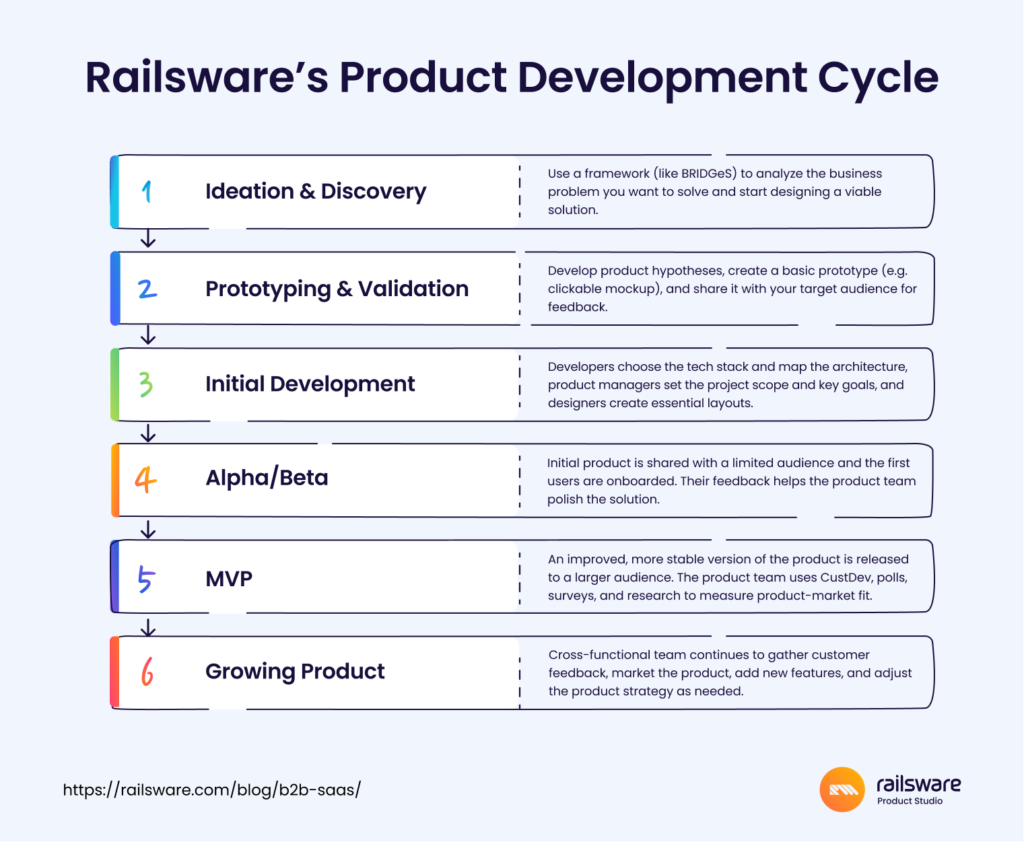
Of course, there’s much more to the process than just these six steps. So check out our post on SaaS product management to learn about some of the key approaches and frameworks worth implementing in your development process.
Tech behind B2B SaaS
Under the hood, the typical B2B SaaS looks something like this:
- Small and simple backend
- 3rd-party API integrations
- Frontend built on JavaScript framework (React.js, Angular.js, Vue.js)
- Hosted with a cloud service provider
But let’s explore each of those points in a bit more detail…
Backend and APIs
SaaS products usually don’t have intricate backends, because the main focus of the server side isn’t to support advanced user interfaces or complex features – it’s to manage the application’s data and logic.
API integrations help fill the gaps and provide additional functionality. For example, there’s Stripe’s Payment Methods API for processing customer transactions or Twilio’s Messaging API for sending SMS messages to customers. And with artificial intelligence currently in the spotlight, more and more SaaS companies are starting to use the OpenAI API too.
We consider Ruby on Rails (RoR) to be one of the best backend frameworks for SaaS MVPs. The framework supports rapid development through principles like Convention Over Configuration and DRY (Don’t Repeat Yourself), is written in a highly expressive, easy-to-read language (Ruby), and comes with access to a huge network of open source code libraries (Ruby Gems). Basically, if you have Ruby developers and you want to launch an MVP fast, RoR is a solid backend choice.
Frontend
Nowadays, the frontends of most SaaS products are built on JavaScript frameworks, such as React, Vue.js, and Angular. They all come with a wide variety of pre-built components and libraries, allowing developers to build rich, interactive, and dynamic user interfaces quickly. And JS frameworks are optimized for performance, meaning you can scale your product without fearing it’ll grow sluggish over time.
In a competitive market, picking a frontend framework definitely shouldn’t be an afterthought. A sophisticated, highly-responsive UI – and a smooth UX – are must-haves for any SaaS product.
Cloud hosting services
Most SaaS organizations pay a monthly fee to have their software hosted on an off-site server(s). The cost ranges from a few dollars to hundreds, even thousands, depending on the size and complexity of your SaaS application.
When considering cloud services, we recommend looking for providers that:
- Respond quickly to support tickets
- Have a strong uptime promise (e.g. AWS offers 100%, but not all do)
- Provide robust security measures so your data and systems remain secure
- Allow you to easily scale your app as your needs evolve
- Let you make regular backups so you can protect your app against failure
Some industry giants are Amazon Web Services (AWS), Microsoft Azure, Google Cloud Platform, and Digital Ocean. However, there are a few smaller alternatives that we would recommend too: check out Fly.io, Render, and – for Rails apps in particular – Railway.
The rise of no-code
There’s another way to build a B2B SaaS MVP that doesn’t involve hiring a development team at such an early stage. And that’s by using no-code tools, such as Webflow, Google Sheets, Airtable, and Zapier. No-code solutions are:
- Cost-efficient: you can get access to pro features for as little as $10-20 a month
- Time-saving: with the right know-how, you can build an MVP in a matter of days
- Easy to use: drag and drop editors, fluid UIs.
For example, the MVP of Comet (a marketplace where companies can source tech freelancers) was built with the no-code platform Bubble and a host of other tools like GSheets and Zapier. As Comet grew and required more customization, it moved away from Bubble – but the team still credits the tool with helping them iterate quickly and find a product-market fit.
How to market B2B SaaS
Serial entrepreneur and investor David Shok says: ‘In the startup world, if your primary focus is on making money, you usually won’t make money.’ That’s vital to remember when you start marketing your product. Efforts shouldn’t be focussed on getting as many signups as possible through aggressive marketing tactics. You need to attract early adopters, not people who are only mildly interested in what your product claims to do.
First of all, start early. Ideally, before you even have a product to sell. The idea is to pitch your raw solution and see if it resonates with your target audience.

Denys Velykozhon
Marketing Lead
The more you do before you have an actual product, the easier it will be to get your first paying users. Remember, it’s not about marketing the product itself. What you need to sell is your solution to the problem.
And make product idea validation a top priority at this early stage. This is the point at which you’ll run some of your first customer development sessions, but don’t stick to taking notes during the interviews. Show participants a demo of your product. If you spot someone who’s genuinely interested, go a step further and actively sell it.
Meanwhile, you should avoid these 3 black holes:
- SEO. It takes time (months, at least) to design a scaled content creation process that brings predictable results, whether you do it yourself or invest in link building services, for example. Focus on less complex marketing tactics first.
- PPC. It’s tempting to pay for traffic from search engines, social media, etc. but there’s no guarantee that this will deliver paying customers to your door. Save your pennies for now.
- Digital PR. Even investing huge sums in influencer marketing won’t help you nab loyal users, at least not at this point in your product’s lifecycle.
If you already have some digital assets, now’s the time to leverage them. For example, if you’re a software developer turned entrepreneur, you might already have:
- Domain knowledge about the problem you are trying to solve
- Network and communities
- Relevant social media subscribers
- Personal brand
- Readers of your personal blog
In our post on how to market new products, we give detailed examples of how to make the most out of social media audiences, blog subscribers, and so on. You can also read it for a deep dive into how to start your marketing efforts from scratch. But here’s a brief rundown of our new product marketing dos and don’ts:
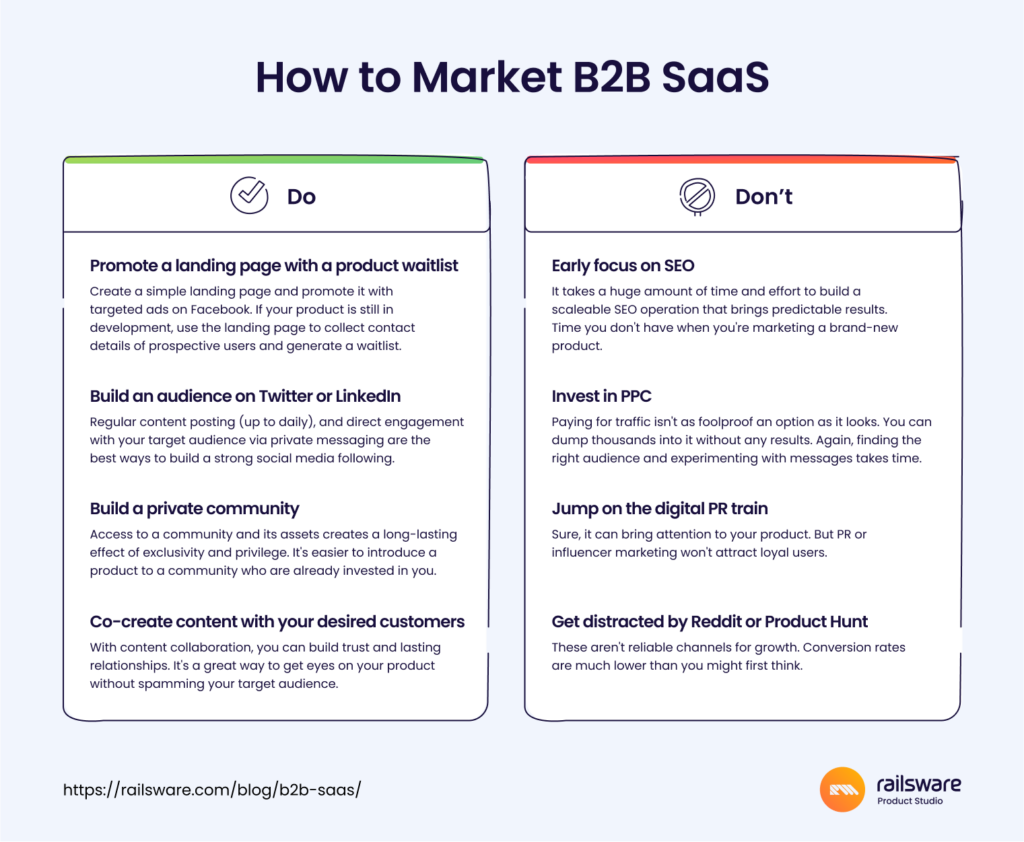
We’ve talked a lot about the level and amount of competition in the B2B SaaS industry. But don’t let that discourage you from aiming high with your marketing efforts. It’s absolutely possible to outperform an industry giant with the right approach.
Let’s take ClickUp as an example. They are less established in the project management space than Jira. Yet, they still have a solid and growing user base, thanks to their clever marketing efforts. Clickup’s campaigns focus on how the product makes users’ lives easier: better UX, no clunky add-ons, bright and simple user interface. The company invests a lot of money in well-placed ads and understands its target customer deeply. This allows them to stand out in a sea of competitors.
Specific SaaS metrics
When it comes to measuring the success of a SaaS product, there are a few key metrics to track. Here’s a breakdown of each:
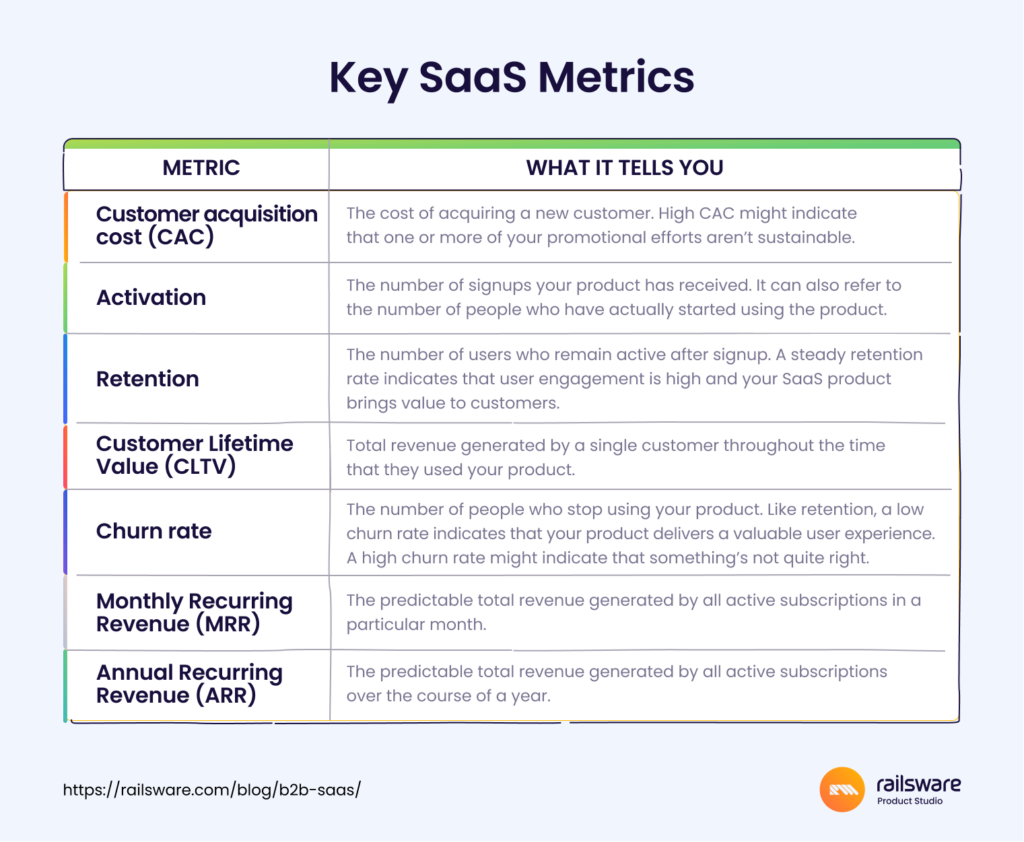
Most of these metrics are specific to the SaaS industry – notably, activation (signups), churn, and recurring revenue. And they shouldn’t be ignored. All of the above provide vital insights into how well your SaaS business is performing on the market, so it’s essential to start tracking them from the moment of launch.
At Railsware, our product managers build custom dashboards so we can accurately measure product success. We find the AARRR/Pirate metrics framework helpful for shaping the main dashboard, as it provides an overview of the product funnel. At a glance, we can see how many users have converted into paid, the level of user engagement, how many customers have churned, and crucially – how all of this data compares to previous months.
But don’t just stick to the metrics on that framework. The final list will look different for every business, depending on your niche, pricing strategy, promotion model, and user base. So, when setting startup metrics, don’t just copy what other companies are doing or take your cues from dashboard templates. Double-check what’s relevant to your specific product.
Common mistakes B2B SaaS founders make
1. Not testing a PoC, prototype, or MVP
As we mentioned earlier, it’s essential to test your product idea before diving head-first into development. That’s what PoCs, prototypes, and MVPs are for – checking if your idea has legs. But it’s not enough to create a product mockup and acknowledge that it works. You need to test it with real customers.
Now, there are some exceptions: it’s not always necessary to create a PoC, particularly when your B2B SaaS isn’t a new concept and won’t be powered by technology you’re unfamiliar with. However, functional prototypes and MVPs should absolutely be shared with real users, or at the very least, test audiences. Promote this basic version of your product, gather customer feedback via surveys/interviews/analytics, and pay attention to what your users like and don’t like. This information will help you build bigger and better.
2. Lack of customer development
Don’t rely solely on market research, buyer personas, or a few online surveys to understand your customers’ needs. Engage directly with your target audience. At Railsware, we invest a lot of time in customer interviews (a key element of the customer development process). During these 30-minute meetings, we ask potential paying users open-ended questions about our product. Those questions are based on hypotheses we’ve crafted in advance, which typically revolve around a user’s experience with our product, or thoughts about our company/brand – it depends on the topic.
The customer profile is very, very important. Find people who are willing to pay for your product. Otherwise, you’ll waste resources on building features for forever-free users.

Yevgen Tsvetukhin
Product Manager
Done right, CustDev gives you invaluable insight into the pain points, behaviors, and motivations of your customers.
3. Aiming for perfection
Many founders delay launching a product because they’re reluctant to release something that doesn’t align with their vision. And putting an imperfect product out into the world is…not exactly the dream. But as we know, the B2B SaaS landscape is highly competitive. Every day spent secretly tuning your product is an opportunity for someone else to come along and do the same thing better. Again, that’s why launching an MVP is so important. It forces you to create a product that matches your customers’ needs – not the picture-perfect model in your own head.
4. Choosing the wrong pricing strategy
Pricing your product too high can deter potential customers from buying it. On the other hand, pricing too low can lead to a situation where you’re not generating enough revenue to break even or make a profit. It’s important to choose a strategy that aligns with your business’s maturity and goals.
So don’t fall into the trap of mimicking competitors or following market trends. Instead, conduct market research, compare pricing models, and talk to your customers to learn more about their budgets and spending habits. And don’t be afraid to adjust your pricing strategy as you grow the product – you’d be surprised by how much you can gain from this.
5. Focusing on the wrong metrics
It’s critical to choose the right metrics for your product from the start. As we discussed earlier, there are a few key metrics you should always track, and building a custom dashboard can help you stay focussed. However, beware of vanity metrics, like website traffic, email subscribers, social media followers, or ad impressions. It’s easy for startuppers to get excited about these big numbers. But none of them are actionable. And they don’t provide an honest insight into how your B2B SaaS company is performing on the market.
Check out our post on the most common startup hiring mistakes for more tips on what to avoid when you’re starting out.
Examples of B2B SaaS products
Mailtrap
Mailtrap is an email delivery platform designed by our team here at Railsware. It allows businesses and developers to send and test emails and manage their email infrastructure performance.
Mailtrap was initially developed as an internal tool, not a B2B SaaS. But we decided to release it to market when we saw how much value our engineers and early adopters in the dev community derived from it. Bear in mind, the first working version of Mailtrap hardly resembled the current product. It was simply a dummy SMTP server that allowed developers to test emails sent from a staging environment.
In the years that followed, we invested heavily in marketing, did plenty of CustDev, and scaled Mailtrap into a full-blown email delivery platform with more than 150K monthly users.
Coupler.io
Coupler.io is another one of our products that started out as an internal tool. We needed a tool that would help us collect and synthesize data from various sources, but none of the existing solutions matched our needs. So we built an Airtable importer, which evolved into an ‘anything’ importer. More plugins were added, and eventually, we merged them to create a standalone product: Coupler.io.
We conducted CustDev interviews and market research to help us validate the product idea. This revealed that Coupler.io had huge potential, and over the years, we’ve scaled into a full-fledged data integration platform trusted by more than 24K businesses worldwide.
Top B2B SaaS companies 2023
How does the rest of the market look? According to G2’s 2023 Best Products for Enterprise list, the highest-rated B2B SaaS companies are:
- Seismic – sales enablement platform
- Mindtickle – sales enablement platform
- Zendesk Support Suite – customer support software
- Confluence – corporate wiki/team workspace software
- Smartsheet – project management platform
- Braze – customer engagement platform
- ServiceNow IT Service Management – IT services management & delivery
- Gong – revenue intelligence platform
- Insider – growth management platform
- Greenhouse – talent acquisition software
- Absorb – learning management system
- Similarweb – web analytics platform
- Veritas Backup Exec – data protection software
- Hubspot Marketing Hub – marketing automation & management platform
- ServiceNow App Engine – low-code development tool
- Salesloft – sales engagement platform
- Cvent Registration – event management platform
- Jira – issue and project tracking software
- Sprout Social – social media management platform
- ZoomInfo SalesOS – sales intelligence platform
The above list confirms that niche is the way to go. None of those SaaS providers try to be all things to every enterprise – they focus on a single business operation (hiring, social media marketing, event management) and offer a targeted solution.
Another good example is BrightBytes, a data and analytics platform for education. We’ve worked with the BrightBytes team since 2013 and saw first-hand how the product grew into a multi-million dollar enterprise by serving a niche audience – schools. In fact, 1 in 5 U.S. schools now uses BrightBytes software.
Final thoughts
In just a couple of decades, B2B SaaS has fundamentally changed the business landscape. As we cited in the opening paragraphs: organizations use an average of 130 apps to get their work done. Not even 30 years ago, that number would have been single digit. And although the market’s grown saturated, the world’s appetite for B2B SaaS hasn’t waned. You can still create a standout product by properly validating your idea, engaging with target customers, choosing the right tech stack and metrics, and taking proactive steps to market it. Need help getting started? Take a peek at our product development services to learn more about how we help our clients build thriving SaaS businesses.
